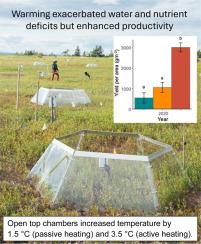尽管野生蓝莓(一种传统的温带管理作物)的水分和营养缺乏加剧,但变暖提高了生产力
IF 5.7
1区 农林科学
Q1 AGRONOMY
引用次数: 0
摘要
全球变暖可能有利于温带作物,因为更适合光合作用的温度,而且具有高田间遗传多样性的传统管理作物,如野生蓝莓,可能在变暖下表现出弹性。然而,气候变暖会加剧水资源短缺,其对作物的总体影响尚不完全清楚。本研究以北美原生水果作物(野生蓝莓)为模型系统,研究了气候变暖对其植物结构、生理和生产力(营养生长和浆果产量)的影响。我们在美国缅因州实施了一项变暖模拟研究,使用主动加热(AH; 3至4°C;平均3.5°C)和被动加热(PH; 1至2°C; 1.5°C)开顶箱,在两年(2019年和2020年)期间与六种基因型的环境对照进行比较。增温,特别是主动增温,导致土壤体积含水量下降7.55%,叶片水势下降-0.49 MPa,叶片叶绿素、N和K浓度降低。然而,我们发现光合速率没有变化,而单茎光合速率由于叶面积的增加而显著增加。我们还发现,在变暖条件下的植物更高,茎直径更大,浆果也更多更大。PH和AH分别使产量提高1.9倍和5.5倍。在高压处理下,产量与更高的光合作用、硼浓度、每茎花数呈正相关,与不同处理的叶绿素浓度呈负相关。总之,我们能够发现气候变暖的积极和消极影响,但提高了这种温带作物的生产力,强调温度上升可能有利于野生蓝莓的生产,当有足够的水和营养存在时。这种具有高度遗传多样性的传统管理作物的复原力为我们如何在全球变化下维持农业系统提供了见解。本文章由计算机程序翻译,如有差异,请以英文原文为准。

Warming enhances productivity despite exacerbated water and nutrient deficits in wild blueberry, a traditionally managed temperate crop
Global warming could be beneficial to temperate crops owing to more suitable temperatures for photosynthesis, and traditionally managed crops with high field genetic diversity, such as wild blueberry, could show resilience under warming. However, warming can exacerbate water deficits, with its overall impacts on crops not fully understood. Here, we used a native North American fruit crop (wild blueberry) managed traditionally with naturally-growing plants and high diversity, as the model system to study warming impacts on its plant structure, physiology, and productivity (vegetative growth and berry yield). We implemented a warming simulation study in the field using active heating (AH; 3 to 4°C; 3.5°C average) and passive heating (PH; 1 to 2°C; 1.5°C) open-top chambers to compare with an ambient control in six genotypes over two years (2019 and 2020) in Maine, USA. Warming, especially active heating, resulted in lower soil volumetric water content (7.55 % decrease) and leaf water potentials (-0.49 MPa decrease) along with lower leaf chlorophyll, N, and K concentrations. However, we found no change in photosynthetic rate, while the photosynthetic rate per stem increased significantly due to increased leaf area. We also found that plants under warming were taller and had larger-in-diameter stems, as well as more and larger berries. The PH and AH increased yields by 1.9 and 5.5-fold, respectively. Yield correlated positively with higher photosynthesis under AH, and with boron concentration, flowers per stem, and negatively with chlorophyll concentrations across treatments. In summary, we were able to find both positive and negative effects of warming, but enhanced productivity in this temperate crop, highlighting that rising temperatures may be a boon to wild blueberry production when sufficient water and nutrients are present. The resilience of this traditionally managed crop with high genetic diversity provides insight into how we can sustain agricultural systems under global change.
求助全文
通过发布文献求助,成功后即可免费获取论文全文。
去求助
来源期刊
CiteScore
10.30
自引率
9.70%
发文量
415
审稿时长
69 days
期刊介绍:
Agricultural and Forest Meteorology is an international journal for the publication of original articles and reviews on the inter-relationship between meteorology, agriculture, forestry, and natural ecosystems. Emphasis is on basic and applied scientific research relevant to practical problems in the field of plant and soil sciences, ecology and biogeochemistry as affected by weather as well as climate variability and change. Theoretical models should be tested against experimental data. Articles must appeal to an international audience. Special issues devoted to single topics are also published.
Typical topics include canopy micrometeorology (e.g. canopy radiation transfer, turbulence near the ground, evapotranspiration, energy balance, fluxes of trace gases), micrometeorological instrumentation (e.g., sensors for trace gases, flux measurement instruments, radiation measurement techniques), aerobiology (e.g. the dispersion of pollen, spores, insects and pesticides), biometeorology (e.g. the effect of weather and climate on plant distribution, crop yield, water-use efficiency, and plant phenology), forest-fire/weather interactions, and feedbacks from vegetation to weather and the climate system.

 求助内容:
求助内容: 应助结果提醒方式:
应助结果提醒方式:


